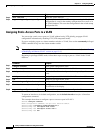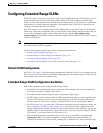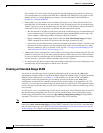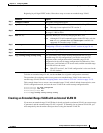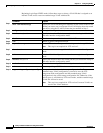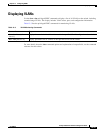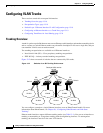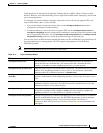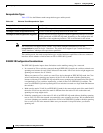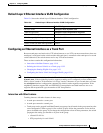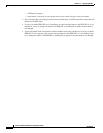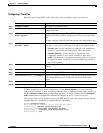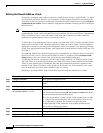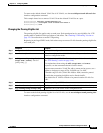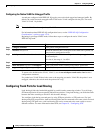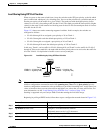
13-18
Catalyst 3750 Switch Software Configuration Guide
OL-8550-09
Chapter 13 Configuring VLANs
Configuring VLAN Trunks
Encapsulation Types
Table 13-5 lists the Ethernet trunk encapsulation types and keywords.
Note The switch does not support Layer 3 trunks. You cannot configure subinterfaces or use the
encapsulation keyword on Layer 3 interfaces. The switch does support Layer 2 trunks and Layer 3
VLAN interfaces, which provide equivalent capabilities.
The trunking mode, the trunk encapsulation type, and the hardware capabilities of the two connected
interfaces decide whether a link becomes an ISL or IEEE 802.1Q trunk.
IEEE 802.1Q Configuration Considerations
The IEEE 802.1Q trunks impose these limitations on the trunking strategy for a network:
• In a network of Cisco switches connected through IEEE 802.1Q trunks, the switches maintain one
spanning-tree instance for each VLAN allowed on the trunks. Non-Cisco devices might support one
spanning-tree instance for all VLANs.
When you connect a Cisco switch to a non-Cisco device through an IEEE 802.1Q trunk, the Cisco
switch combines the spanning-tree instance of the VLAN of the trunk with the spanning-tree
instance of the non-Cisco IEEE 802.1Q switch. However, spanning-tree information for each VLAN
is maintained by Cisco switches separated by a cloud of non-Cisco IEEE 802.1Q switches. The
non-Cisco IEEE 802.1Q cloud separating the Cisco switches is treated as a single trunk link between
the switches.
• Make sure the native VLAN for an IEEE 802.1Q trunk is the same on both ends of the trunk link. If
the native VLAN on one end of the trunk is different from the native VLAN on the other end,
spanning-tree loops might result.
• Disabling spanning tree on the native VLAN of an IEEE 802.1Q trunk without disabling spanning
tree on every VLAN in the network can potentially cause spanning-tree loops. We recommend that
you leave spanning tree enabled on the native VLAN of an IEEE 802.1Q trunk or disable spanning
tree on every VLAN in the network. Make sure your network is loop-free before you disable
spanning tree.
Table 13-5 Ethernet Trunk Encapsulation Types
Encapsulation Function
switchport trunk encapsulation isl Specifies ISL encapsulation on the trunk link.
switchport trunk encapsulation dot1q Specifies IEEE 802.1Q encapsulation on the trunk link.
switchport trunk encapsulation negotiate Specifies that the interface negotiate with the neighboring interface to become
an ISL (preferred) or IEEE 802.1Q trunk, depending on the configuration and
capabilities of the neighboring interface. This is the default for the switch.



